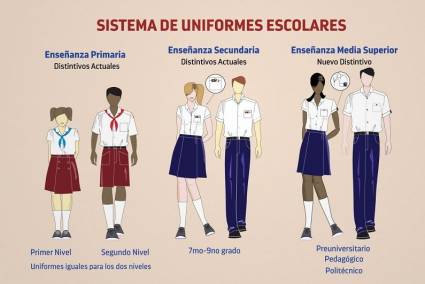Our school uniforms symbolize one of the conquests of the Revolution. Whatever the economic scenario, the Cuban State will always ensure that they are preserved as an expression of the highest values of unity and a sense of belonging.
The result of the redesign that our schoolchildren will wear from this course on, will be introduced – as is natural – in a phased manner; It is the fruit of the integrating vision of the National Design Office, from whom the Ministry of Education requested this beautiful task.
Our work team defined, as a strategic concept, the unification of color in the structures of the different teaching levels; being the white in the upper garments the color that connects at all levels. Red and blue are kept in lower garments to symbolically enhance the colors of the flag.
In the same way, this decision promotes an ecologically responsible attitude, by prolonging the useful life of the garments, the student can move with the same uniform from one educational level to another and contribute in favor of the reduction of waste. This projection also has positive logistical implications: for the Light Industry Business Group (GEMPIL), it reduces the number of colors to import and fragments production processes much less. Regarding the distribution and commercialization carried out by the Ministry of Internal Commerce (MINCIN), it offers greater satisfaction to families and students by concentrating in the same store similar options for a greater spectrum of education levels.
Once again, the conception of the school uniform system has been evaluated, from the historical point of view, to temper it to the new times: Thinking as a country! We respond to the demands of the students in the congresses of the José Martí Pioneers Organization (OPJM) and the Middle School Federation (FEEM).
From the vision of costume design, it is aimed at redesign. By preserving structures and solutions that have been validated for years for their use and functionality, we pay tribute to the good design of previous uniforms:
The use of the short skirt is extended to secondary education, which was previously a privilege of upper secondary education.
In this way, zippers are eliminated as closure accessories and only buttons are used that are much more viable in every way.
Bottoms for primary school children are unified, thus expanding the possibility of finding sizes for those who do not fit the average of the physical parameters of their age.
The proposal seeks to find the right balance between satisfying the preferences of students and the productive dynamics of light industry. With the transformation of only four structures within the entire system, namely: skirt for elementary school, blouse for elementary school, as well as shirt and blouses for secondary and upper secondary education, these expectations are met, while optimizing and simplifying procedures. Mold processes and size scaling in which the industry should be used, taking the previous uniform system as a reference.
If we go to the details, the differentiation between the teachings that now unify their uniform modules (secondary education and upper secondary education), is expressed in two elements of the upper garments that are within the reach of production: buttons and a distinctive textile solved by making the most of the tissue. The badge for upper secondary education, among many other advantages, will be removably located on the left sleeve to facilitate the maintenance of white garments during washing, and will guarantee, by color, the respective differentiation of this level.
Blue: pre-university and Sports Initiation schools (EIDES).
Red: pedagogical, pedagogical schools, Teacher Training schools for Professional Technical Teaching.
Target: technological, Artistic Teaching, schools for Physical Education Teachers.
The colors of the country in Cuban school uniforms
New distinctive for Upper Secondary Education.
As part of the professional technical performance, from an inclusive and participatory premise and in the practice of providing feedback on the proposal, students from more than 6000 schools were surveyed. Adjusted to the biosecurity requirements during the COVID-19 pandemic, between the months of November and December 2020 the opinion about these changes was consulted at all levels of education and all provinces of the country. The process was developed through a methodology developed in conjunction with the FEEM and the OPJM, and was implemented with the production of audiovisual materials conceived by the ONDI and materialized in conjunction with the Computer and Audiovisual Media Company (CINESOFT). These materials were carefully designed, according to the visual codes that communication demands for each level of education.
With the motto “a uniform that looks more like you”, it was possible to confirm and statistically validate, with a satisfaction above 80 percent on average, the acceptance of all modifications:
Taken from the site http://www.ondi.cu/

